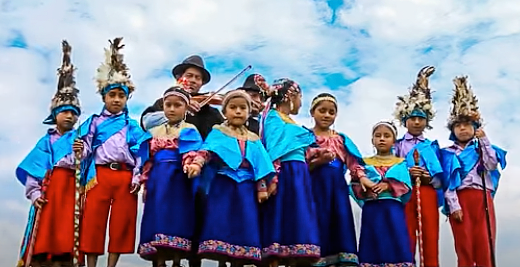The Raymi Festivals of Saraguro Loja Ecuador

Raymi, the Quechua word for "Festival," is celebrated four times a year during annual solstices and equinoxes by the indigenous highland peoples of Ecuador. These celebrants are united by common indigenous dialects, their Incan heritage, and their location along the Incan highway known as Qhapaq or Kapak Ñan. The impressive ancient road was a backbone of the Incan empire. This amazing engineering feat stretches from north to south along the highlands of Ecuador and loops the mountains and shores of western south America stretching all the way to Argentina.
It is believed earlier Palta and Cañari indigenous were displaced by the Quechua in Ecuador’s sierras during the Incan conquests. Remnants of the Cañari people are to be found in Azuay province, and of the Palta culture in Loja Province. Incan armies moving northward from Peru overran or bypassed the original inhabitants of Ecuador’s mountain region and then relocated some of their Quechua subjects to hold and manage the land for their empire. Loja’s Quechua people in the town of Saraguro may have come from Peru or what is now Bolivia, both part of what was the vast Incan holdings. Qhapaq Ñan road intersects Loja briefly in Saraguro in the north of the province before continuing on to Ingapirca archaeological ruins near Cuenca, Ecuador, further north.
The four Raymi celebrations are a major part of the reclamation of Quechua culture nearly lost after the European conquest of South America when the Spanish outlawed these indigenous religious rites. Inti Raymi, the festival of the sun god and most important occasion of the four, was first reconstructed in contemporary times from the famous recollections of Garcilaso de la Vega. Known as "the Incan," Vega was a romantic creole (criollo) figure from early colonial Peru who was said to be the illegitimate son of a conquistador and an indigenous noblewoman. Centuries later, in June 1944, Peruvian author Faustino Espinoza Navarro, supported by Cusco’s Institute of American Art and a group of indigenous actors, performed the first Inti Raymi ceremony in modern times. The new Raymi festivals have been adopted by Quechua groups throughout the Sierra range of South America. In Loja, Raymi festivals were brought back by the people of Saraguro at the beginning of the 21st century.
Saraguro and the smaller nearby parish of San Lucas host among the most lively and authentic Raymi celebrations in Ecuador. They can be experienced first hand by visitors in these indigenous towns in the north of Loja Province (at the southern end of the Andes mountains in Ecuador). Saraguro is located on Highway E35 between the city of Cuenca, a UNESCO world heritage site, and Loja, Ecuador’s oldest colonial city. The welcoming people of Saraguro are artists, performers, and farmers - many of whom proudly wear their heritage dress every day. The four major Raymi celebrations produce and strengthen community solidarity with every passing year.
The first Quechua Raymi festival in Saraguro happens during the Spring Equinox, on or around March 20th. Pawkar Raymi, or flower festival, begins the Quechua religious cycle on one of two of the year’s equinoxes ("equal nights") when daylight and darkness are roughly the same. Next, Inti Raymi, celebrating the Quechua sun god, takes place during the summer solstice near June 21st. Sometime close to September 23rd is the second annual equinox and Killa Raymi or moon festival. The cycle of festivals completes at the end of the year with Kapak Raymi in honor of the winter solstice around December 21st.
To arrange your to visit Saraguro accompanied by an English-Spanish translator during the Raymi festivals or any time of the year - there is always something to see in this unique destination - contact Life in Loja by email, or phone/WhatsApp at 593-098-674-5994.
Life In Loja is registered under Ecuador’s department of intellectual rights as of 2022.
Story: Wiki, Discover Peru




Comments
Post a Comment